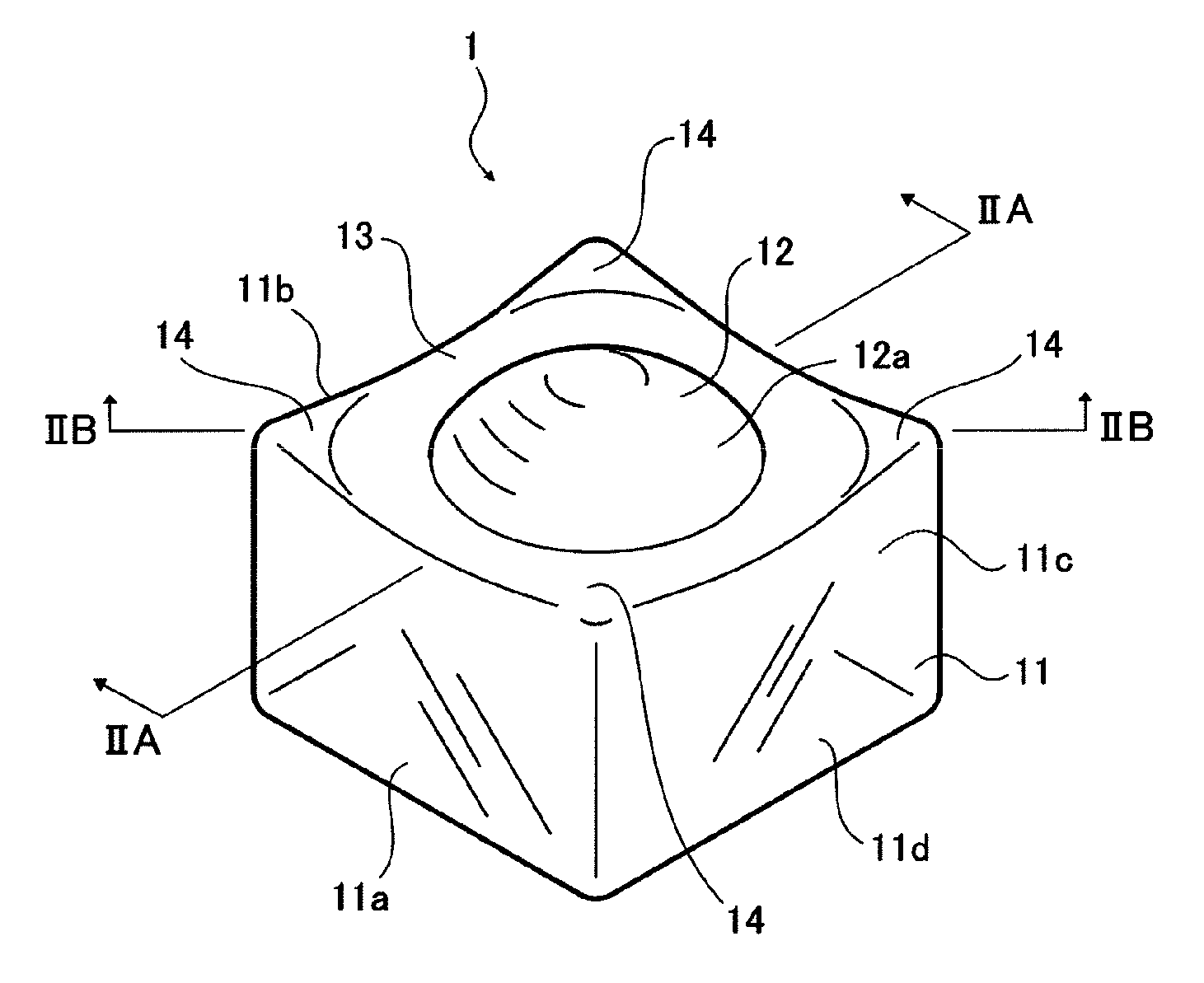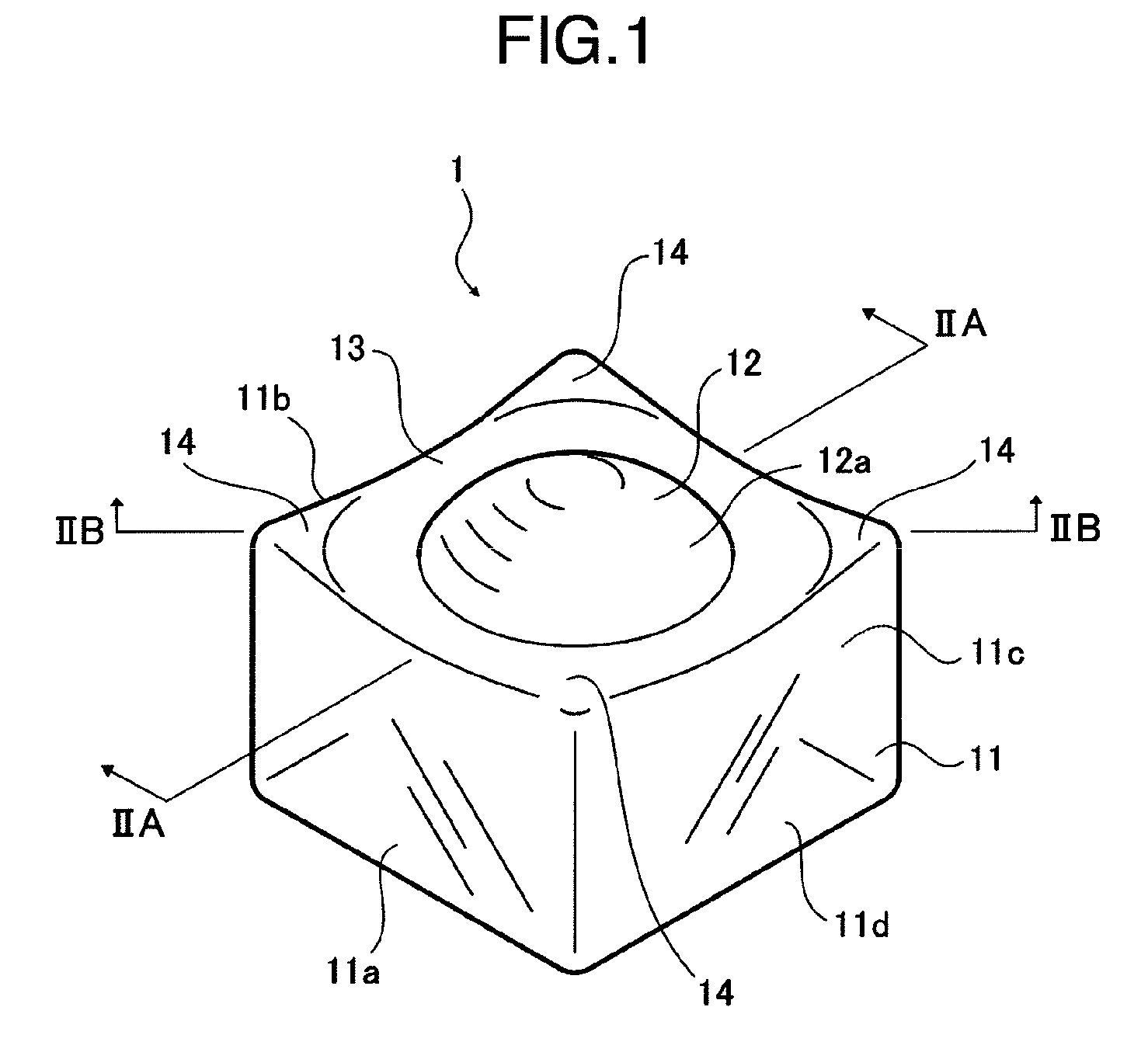Production method of optical element, optical element forming mold and optical element
a production method and technology of optical elements, applied in the field of optical element production methods, optical element forming molds and optical elements, can solve the problems of difficult to supply products which satisfy commercial demands, difficult to allow the commercial availability of optical lenses at low cost, lens surface is subjected to scratches which are optically detrimental, etc., and achieves a wider bonding area and high productivity.
- Summary
- Abstract
- Description
- Claims
- Application Information
AI Technical Summary
Benefits of technology
Problems solved by technology
Method used
Image
Examples
first embodiment
[0034]FIG. 1 is a schematic perspective view which shows an external appearance of an optical element 1 in a first embodiment of the present invention. FIGS. 2A and 2B are longitudinal sectional views which show the optical element 1 shown in FIG. 1, that is, FIG. 2A is a sectional view along line IIA-IIA in FIG. 1, and FIG. 2B is a sectional view along line IIB-IIB in FIG. 1.
[0035]The optical element 1 shown in FIG. 1 incorporates a body portion (quadrate body portion) 11 having a substantially rectangular parallelepiped shape, a lens portion (incident side lens or a first lens portion) 12 having a curved shape lens surface 12a which is formed being protruded from one surface (upper surface) of the body portion 11, a flat part 13 formed in the one surface of the body portion 11, adjacent to the lens portion 12, and the protrusions (bulged portions) which are each formed at four corners of the one surface of the body portion 11, adjacent to the flat part 13.
[0036]Further, the optica...
third embodiment
[0112]FIG. 14 is a perspective view which shows the external appearance of an optical element 1 in a third embodiment of the present invention. Further, FIGS. 15A to 15C are views which shows an projection of the optical element 1 shown in FIG. 14, that is, FIG. 15A is a front view, FIG. 15B is a rear view and FIG. 15C is a plan view. Further, FIG. 16A and FIG. 16B are longitudinal sectional views which show the optical element 1 shown in FIG. 14, that is, FIG. 16A is a sectional view along line XVIA-XVIA in FIG. 15A and FIG. 15B is a sectional view along line XVIB-XVIB in FIG. 15A.
[0113]The optical element 1 shown in FIGS. 14 to 16B is composed of, similar to the first embodiment, a substantially parallelepiped body portion (quadrate body portion) 11, a lens portion (an incident side lens, a first lens portion) 12 having a lens surface 12a of a curved surface shape, which are formed on one surface (front side surface) of the body portion 11 so as to be protruded from the surface th...
fourth embodiment
[0137]FIG. 23 is a perspective view which shows a optical element 1 in a fourth embodiment of the present invention. Further, FIG. 24 is a front view which shows the optical element 1 shown in FIG. 23.
[0138]The optical element 1 shown in FIGS. 23 and 24, includes a quadrate body portion (a quadrangular body portion) 11, a lens portion (incident side lens, first lens portion) 12 having a lens surface 12a in a curved surface shape, which is protruded from one surface (front side surface) of the body portion 11, a flat part 13 which is formed in the one surface of the body portion 11, adjacent to the lens portion 12, protrusions 16 (bulged portions) formed in the one surface of the body portion 11, respectively at the four corners thereof, and a slope portion 15 located between the flat part 13 and the protrusions 14.
[0139]Further, the optical element 1 also includes a lens portion (an emergent side lens, second lens portion) 15 having a lens surface 16a in a curved surface shape, whic...
PUM
| Property | Measurement | Unit |
|---|---|---|
| included angle | aaaaa | aaaaa |
| shape | aaaaa | aaaaa |
| inter distance | aaaaa | aaaaa |
Abstract
Description
Claims
Application Information
 Login to View More
Login to View More - R&D
- Intellectual Property
- Life Sciences
- Materials
- Tech Scout
- Unparalleled Data Quality
- Higher Quality Content
- 60% Fewer Hallucinations
Browse by: Latest US Patents, China's latest patents, Technical Efficacy Thesaurus, Application Domain, Technology Topic, Popular Technical Reports.
© 2025 PatSnap. All rights reserved.Legal|Privacy policy|Modern Slavery Act Transparency Statement|Sitemap|About US| Contact US: help@patsnap.com



